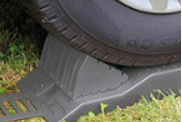Corgimajor
We've owned our T6.1 Ocean for over a year, but have been lucky to stop on sites with relatively flat pitches. We were fortunate that on the only site we did visit that did have a slope (on Jersey) the site owner lent us a some chocks. However that experience reminded me that as you have to let the handbrake off to rotate the drivers seat, things can become rather uncoordinated if you are inexperienced!!
I would like to buy some wheel chocks to give us more flexibility in choosing sites in future, but I also need some guidance on what chocks to buy to avoid the handbrake release /slide back down the chock issue. Either that or guidance on how best to manage the handbrake release/swing driver seat process. NB. It occured to me anyone driving a LH drive California, will most likely avoid this dilemma as the kitchen is behind the driver's seat, so swinging the passenger seat is always preferable in a two person journey. That said advice on this issue from all owners whether RH or LH drive will be appreciated .
I would like to buy some wheel chocks to give us more flexibility in choosing sites in future, but I also need some guidance on what chocks to buy to avoid the handbrake release /slide back down the chock issue. Either that or guidance on how best to manage the handbrake release/swing driver seat process. NB. It occured to me anyone driving a LH drive California, will most likely avoid this dilemma as the kitchen is behind the driver's seat, so swinging the passenger seat is always preferable in a two person journey. That said advice on this issue from all owners whether RH or LH drive will be appreciated .

















